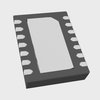Part Details for AP6508FE-7 by Diodes Incorporated
Results Overview of AP6508FE-7 by Diodes Incorporated
- Distributor Offerings: (1 listing)
- Number of FFF Equivalents: (0 replacements)
- CAD Models: (Request Part)
- Number of Functional Equivalents: (0 options)
- Part Data Attributes: (Available)
- Reference Designs: (Not Available)
Tip: Data for a part may vary between manufacturers. You can filter for manufacturers on the top of the page next to the part image and part number.
AP6508FE-7 Information
AP6508FE-7 by Diodes Incorporated is a Switching Regulator or Controller.
Switching Regulator or Controllers are under the broader part category of Power Circuits.
A power circuit delivers electricity in order to operate a load for an electronic device. Power circuits include transformers, generators and switches. Read more about Power Circuits on our Power Circuits part category page.
Price & Stock for AP6508FE-7
| Part # | Distributor | Description | Stock | Price | Buy | |
|---|---|---|---|---|---|---|
|
DISTI #
AP6508FE-7
|
Avnet Americas | - Tape and Reel (Alt: AP6508FE-7) RoHS: Compliant Min Qty: 3000 Package Multiple: 3000 Lead time: 111 Weeks, 0 Days Container: Reel | 0 |
|
RFQ |
Part Details for AP6508FE-7
AP6508FE-7 CAD Models
AP6508FE-7 Part Data Attributes
|
|
AP6508FE-7
Diodes Incorporated
Buy Now
Datasheet
|
Compare Parts:
AP6508FE-7
Diodes Incorporated
Switching Regulator, Current-mode, 650kHz Switching Freq-Max, PDSO14, 4 X 3 MM, GREEN, DFN-14
|
| Part Life Cycle Code | Obsolete | |
| Ihs Manufacturer | DIODES INC | |
| Part Package Code | DFN | |
| Package Description | 4 X 3 MM, GREEN, DFN-14 | |
| Pin Count | 14 | |
| Reach Compliance Code | compliant | |
| ECCN Code | EAR99 | |
| HTS Code | 8542.39.00.01 | |
| Factory Lead Time | 111 Weeks | |
| Samacsys Manufacturer | Diodes Incorporated | |
| Additional Feature | ALSO OPERATES IN ADJUSTABLE MODE FROM 0.81 TO 15V | |
| Analog IC - Other Type | SWITCHING REGULATOR | |
| Control Mode | CURRENT-MODE | |
| Control Technique | PULSE WIDTH MODULATION | |
| Input Voltage-Max | 21 V | |
| Input Voltage-Min | 4.5 V | |
| Input Voltage-Nom | 12 V | |
| JESD-30 Code | R-PDSO-N14 | |
| Length | 4 mm | |
| Number of Functions | 1 | |
| Number of Terminals | 14 | |
| Operating Temperature-Max | 85 °C | |
| Operating Temperature-Min | -20 °C | |
| Output Voltage-Nom | 5 V | |
| Package Body Material | PLASTIC/EPOXY | |
| Package Code | HVSON | |
| Package Equivalence Code | SOLCC14,.12,20 | |
| Package Shape | RECTANGULAR | |
| Package Style | SMALL OUTLINE, HEAT SINK/SLUG, VERY THIN PROFILE | |
| Peak Reflow Temperature (Cel) | NOT SPECIFIED | |
| Qualification Status | Not Qualified | |
| Seated Height-Max | 0.65 mm | |
| Surface Mount | YES | |
| Switcher Configuration | BUCK | |
| Switching Frequency-Max | 650 kHz | |
| Temperature Grade | OTHER | |
| Terminal Form | NO LEAD | |
| Terminal Pitch | 0.5 mm | |
| Terminal Position | DUAL | |
| Time@Peak Reflow Temperature-Max (s) | NOT SPECIFIED | |
| Width | 3 mm |
AP6508FE-7 Frequently Asked Questions (FAQ)
-
The recommended PCB layout for optimal thermal performance involves placing thermal vias under the IC, using a solid ground plane, and keeping the thermal path as short as possible. A 4-layer PCB with a dedicated thermal layer is also recommended.
-
To ensure stable operation with a high-ESR output capacitor, it's recommended to add a small ceramic capacitor (e.g., 10nF) in parallel with the output capacitor to improve the overall capacitor ESR. Additionally, the output capacitor should be placed close to the IC to minimize the loop inductance.
-
The maximum allowed voltage on the EN pin is 6V. Exceeding this voltage may damage the internal circuitry. It's recommended to use a voltage divider or a clamp circuit to limit the voltage on the EN pin if the input voltage exceeds 6V.
-
The AP6508FE-7 is rated for operation up to 125°C. However, the device's performance and reliability may degrade at high temperatures. It's recommended to derate the output current and ensure proper thermal management to prevent overheating.
-
To troubleshoot oscillations or instability issues, check the PCB layout for any signs of resonance or noise coupling. Ensure that the input and output capacitors are properly decoupled, and the feedback loop is properly compensated. Also, verify that the output voltage is within the specified range and the output current is within the recommended limits.
